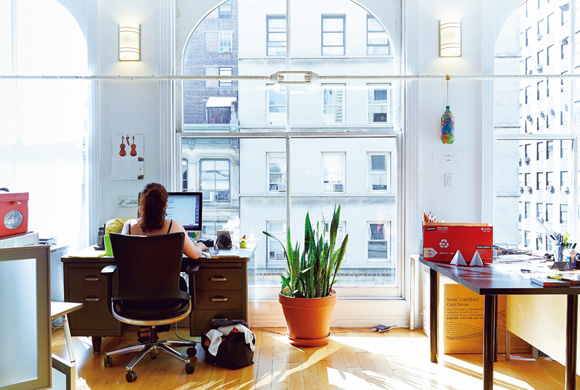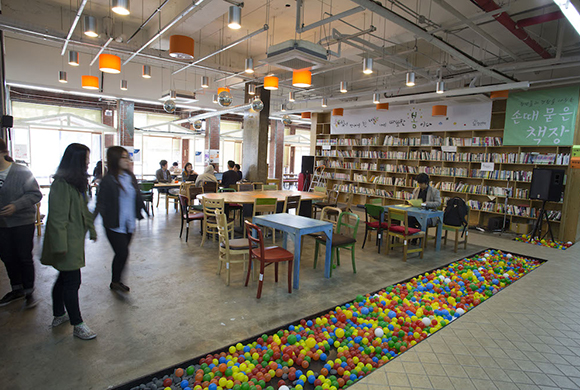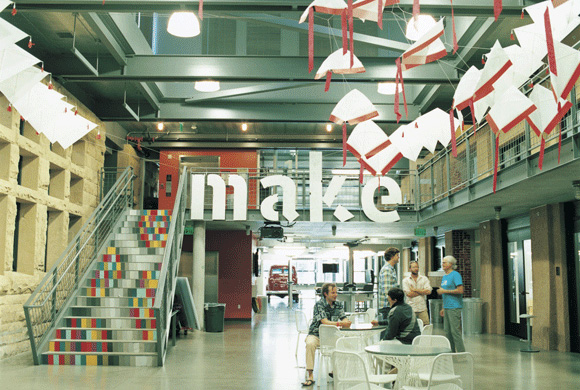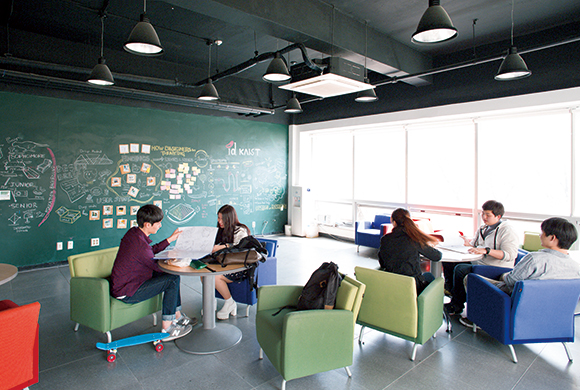Workplace
Sep. 1, 2014
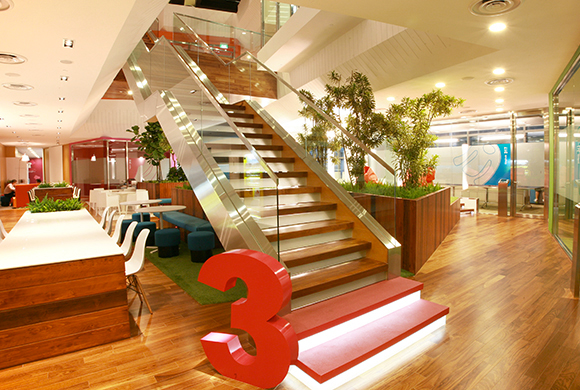
A large staircase that accelerates “agile working”
World-leading consumer products manufacturer
[Unilever] Singapore
With global headquarters in London and Rotterdam, Unilever is one of the world’s largest consumer manufacturers; its products are almost universally known.
Examining sales reports by region, Western Europe accounts for 27 percent of the total, with Asia, Africa, Eastern and Central Europe and the Middle East making up 40 percent (the US makes up the remaining 33 percent). Asia, Australia and New Zealand make up a region called AAC, with headquarters for the region in the trade center of Singapore. The office here is driving the growth of the business in the AAC region.
“The Singapore office includes the brand and marketing departments, but it was divided into four different locations,” says Praveen Sharma, Programme Manager at the Unilever office in Singapore. “Despite Singapore being a small city, we had our business centers located all over the place, so it wasn’t an efficient condition. That is why we began the project to bring everything together in one place.”
The most important factor of the office relocation project was the improvement of productivity and performance. It wasn’t limited to these two factors, however. “The employees’ happiness was also an important factor,” Mr. Sharma says. It’s been three years since the new office was completed—have they reached their goals?
“One major change that came with the relocation of the office was the use of shared desks,” Mr. Sharma says. “The Singapore office is the headquarters for the South East Asia and Australasia region, so about 60 percent of employees will be out of the office on business trips at any one time. To make efficient use of the office space, we stopped providing each employee with their own fixed space. Of course, while we took the fixed seating away from the employees, we introduced new facilities that we felt would more than compensate them for this.”
These facilities included a hair salon, a facial and massage spa, sports gym, a variety of meeting spaces, and a media lab where employees can try out many of the newest gadgets and technologies. The sport gym was set up in a contract with the major Singapore company FitnessFirst, with the company paying for all costs associated with its use.
 To the side of the office’s reception area is a Ben & Jerry’s shop, the ice cream maker that became part of Unilever in 2000—a special service for visitors.
To the side of the office’s reception area is a Ben & Jerry’s shop, the ice cream maker that became part of Unilever in 2000—a special service for visitors.
Founded::1930
Sales:€49.8 billion
Employees: 174,000 (2013)
http://www.unilever.com
 The hair salon, available to all employees. This more than covers any loss employees might feel about losing their own fixed seat.
The hair salon, available to all employees. This more than covers any loss employees might feel about losing their own fixed seat.
Unilever stresses the importance of agile working—the concept that employees can work anywhere and at any time—something that had a profound influence on the design of the new office. “Our approach to thinking about agile working is based on three main pillars: the workspace, IT and human resources practice,” says Mr. Sharma.
Workspace refers to the implementation of shared desks as mentioned previously, and is seen in the range of meeting spaces which were constructed. Supporting this is the second pillar, IT. The office has complete WiFi coverage, with an increased number of spaces where video conferencing can be conducted, both of which have helped to create the environment where people really can work anywhere at any time. Human resources practice is shown in a softening of working hours regulations. Employees with children, for example, might arrive late to work because they have to take the children to preschool, but could then leave work late; working from home is also possible. Another example is that, if an employee works long hours during four days of one week, they then can take off three days from work.
“One other major feature is the large atrium at the center of each floor built around the staircase,” Mr. Sharma says. “Before this, many people did all their work on their own floor, at their own desk, throughout the entire day, so the usual case was that they had no idea of what people were doing on other floors. But by creating the staircase that passes through the center of other floors there is a greater sense of curiosity about what is happening on other floors, and it is easier for them to move up or down and communicate with people in other departments.
The Singapore office is a leased facility. Because of this, the company has the responsibility to restore it to its original condition when it leaves the building. But the company feels that, compared to the cost of building or demolishing the staircase, the benefits to the company in creating the central staircase in terms of communication are much higher.
Currently, 900 employees work in the Singapore office. The office move not only had a favorable influence on the performance of the whole of Unilever, the employees themselves have also seen the change in a very favorable way. In the results of a questionnaire which asked employees about things such as workplace satisfaction, whether the needed tools and technology resources were available and whether they were satisfied in what they provide the company, employees were overwhelmingly positive about their feelings of satisfaction.
It also showed that, where sections were previously separated, today there is frequent collaboration between members of the brand and marketing departments. “With all employees housed in one building, the communication between employees of different fields has increased,” Mr. Sharma says. “By providing for communications beyond the people’s own work area, we can see a process in which there is much more sharing of knowledge and success stories.”
From a global viewpoint as well, the market environment for the consumer goods industry is a very tough one, with all companies having to struggle very hard to ensure profitability. Cost-cutting is one important strategy for Unilever, and while the new office in Singapore was built with that in mind, naturally, says Mr. Sharma, “An office is only infrastructure, so it doesn’t result in revenue by itself.”
It’s not just reducing costs, but about not holding back on the necessary investment. By reducing office costs while also improving productivity and performance while also pursuing the Unilever strategy for happy employees, it can be said that so far this project has been a success.
Consultancy for Work Style:in-house
Interior Design: SCA design (a member of the ONG&ONG Group)
Architect: SCA design (a member of the ONG&ONG Group)


The wide atrium space around the staircase. This expansive opening allows other floors to be seen, and encourages movement between the floors. Meeting spaces are available near the staircase.






